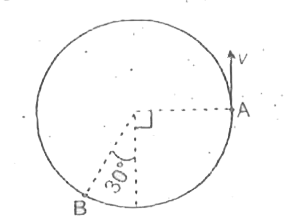A body of mass 10 kg moves with a constant speed v of 2 ms−1 along a circular path of radius 8 m. The power produced by the body will be
10 Js−1
98 Js−1
49 Js−1
zero
The correct Answer is:D
To solve the problem of finding the power produced by a body of mass 10 kg moving with a constant speed of 2 m/s along a circular path of radius 8 m, we can follow these steps:
Step 1: Understand the motion
The body is moving in a circular path at a constant speed. This means that while the speed is constant, the direction of the velocity is continuously changing.
Hint: Remember that in circular motion, the velocity vector is always tangent to the path of the circle.
Step 2: Identify the forces acting on the body
In circular motion, the body experiences a centripetal force directed towards the center of the circle. This force is necessary to keep the body moving in its circular path.
Hint: The centripetal force can be calculated using the formula Fc=mv2r, where m is the mass, v is the speed, and r is the radius of the circular path.
Step 3: Calculate the centripetal force
Using the given values:
- Mass m=10kg
- Speed v=2m/s
- Radius r=8m
The centripetal force Fc can be calculated as follows:
Fc=mv2r=10kg×(2m/s)28m=10×48=408=5N
Hint: This force is directed towards the center of the circular path.
Step 4: Determine the power produced
Power is defined as the rate at which work is done. In this case, power P can be calculated using the formula:
P=F⋅v
Where F is the force vector and v is the velocity vector.
Since the centripetal force is always directed towards the center of the circle and the velocity is tangent to the circle, the angle θ between the force and the velocity is 90 degrees.
Hint: Recall that cos(90∘)=0.
Step 5: Calculate the power
Substituting the values into the power formula:
P=F⋅v⋅cos(θ)=5N⋅2m/s⋅cos(90∘)=5⋅2⋅0=0W
Conclusion
The power produced by the body is 0W.
Final Answer: The correct option is 0 Joules per second.
The body is moving in a circular path at a constant speed. This means that while the speed is constant, the direction of the velocity is continuously changing.
In circular motion, the body experiences a centripetal force directed towards the center of the circle. This force is necessary to keep the body moving in its circular path.
Using the given values:
- Mass m=10kg
- Speed v=2m/s
- Radius r=8m
Fc=mv2r=10kg×(2m/s)28m=10×48=408=5N
Power is defined as the rate at which work is done. In this case, power P can be calculated using the formula:
P=F⋅v
Where F is the force vector and v is the velocity vector.
Substituting the values into the power formula:
P=F⋅v⋅cos(θ)=5N⋅2m/s⋅cos(90∘)=5⋅2⋅0=0W
The power produced by the body is 0W.
Topper's Solved these Questions
- WORK, ENERGY AND POWERBOOK - DC PANDEY ENGLISHCHAPTER - WORK, ENERGY AND POWEREXERCISE - EXERCISES(TAKING IT TOGETHER)
83 Videos
- WORK, ENERGY AND POWERBOOK - DC PANDEY ENGLISHCHAPTER - WORK, ENERGY AND POWEREXERCISE - MEDICAL ENTRANCE SPECIAL QUESTIONS
16 Videos
- WORK, ENERGY AND POWERBOOK - DC PANDEY ENGLISHCHAPTER - WORK, ENERGY AND POWEREXERCISE - CHECK POINT 6.2
20 Videos
- WORK, ENERGY & POWERBOOK - DC PANDEY ENGLISHCHAPTER - WORK, ENERGY & POWEREXERCISE - Level 2 Comprehension Based
2 Videos
- WORK, POWER AND ENERGYBOOK - DC PANDEY ENGLISHCHAPTER - WORK, POWER AND ENERGYEXERCISE - E Integer Type Questions
11 Videos
Similar Questions
When a body moves with a constant speed along a circle
View SolutionAn object of mass 5 kg moves at a constant speed of 6 m/s in a circular path of radius 2m. Find the magnitude of the object's acceleration and the net force responsible for its motion.
View SolutionA particle of mass M moves with constant speed along a circular path of radius r under the action of a force F. Its speed is
View SolutionA car of mass 1000 kg is moving with a speed of 40ms−1 on a circular path of radius 400m. If its speed is increasing at the rate of 3ms−2 the total force acting on the car is
View SolutionA particle of mass m moves with constant speed v on a circular path of radius r as shown in figure. The average force on it during its motion from A to B is

View SolutionA particle of mass m moves with constant speed v on a circular path of radius r. Find magnitude of average force on it in half revolution.
View SolutionAn object of mass m moves with constant speed in a circular path of radius r under the action of a force of constant magnitude F. the kinetic energy of object is
View SolutionA particle moves with constant speed v along a circular path of radius r and completes the circle in time T. The acceleration of the particle is
View SolutionWhy is the motion of a body moving with a constant speed around a circular path said to be accelerated ?
View SolutionA car is moving with a speed of 30 ms−1 on a circular path of radius 500 m. If its speed is increasing at the rate of 2 ms−2 , the net acceleration of the car is
View Solution
